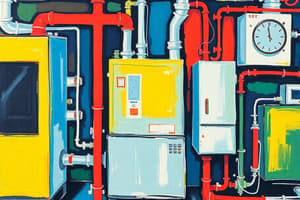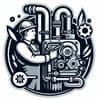Podcast
Questions and Answers
Maximum work that could be secured by expanding the gas over a given pressure range is the __________ work.
Maximum work that could be secured by expanding the gas over a given pressure range is the __________ work.
isothermal
For a spontaneous process, free energy:
For a spontaneous process, free energy:
- increases
- is zero
- and entropy both decrease
- decreases whereas the entropy increases (correct)
A refrigeration cycle is a reversed heat engine.
A refrigeration cycle is a reversed heat engine.
True (A)
Which of the following has the maximum value of the co-efficient of performance (COP) for a given refrigeration effect?
Which of the following has the maximum value of the co-efficient of performance (COP) for a given refrigeration effect?
In a working refrigerator, the value of COP is always:
In a working refrigerator, the value of COP is always:
__________ increases with increase in pressure.
__________ increases with increase in pressure.
A refrigerator may be termed as a:
A refrigerator may be termed as a:
The fugacity of each component in a stable phase at constant pressure and temperature __________ as its mole fraction increases.
The fugacity of each component in a stable phase at constant pressure and temperature __________ as its mole fraction increases.
Entropy is a measure of the __________ of a system.
Entropy is a measure of the __________ of a system.
A chemical reaction will occur spontaneously at constant pressure and temperature, if the free energy:
A chemical reaction will occur spontaneously at constant pressure and temperature, if the free energy:
Flashcards are hidden until you start studying
Study Notes
Thermodynamics Fundamentals
- Maximum work obtainable from gas expansion over a pressure range is termed as isothermal work, adiabatic work, isentropic work, or none of these.
- In a spontaneous process, free energy decreases while entropy increases.
- Internal energy change during a complete cycle in a cyclic process is zero.
- A refrigeration cycle represents a reversed heat engine, maximizing coefficient of performance (COP) with vapor compression using an expansion valve.
Key Thermodynamic Processes and Properties
- Heating water at atmospheric pressure is classified as an isobaric process.
- The Van Laar equation is relevant to activity coefficients in binary solutions, not ternary or azeotropic mixtures.
- High viscosity is an undesirable property for effective refrigerants, while high specific heat and latent heat of vaporization may also be issues.
Refrigeration and Phase Behavior
- Solubility of a substance that dissolves with volume increase and heat release is favored by low pressure and high temperature conditions.
- For a stable phase at constant pressure and temperature, fugacity increases with mole fraction.
- Entropy quantifies system disorder; higher entropy indicates greater disorder.
Properties of Thermodynamic Systems
- Not all properties are intensive; chemical potential and surface tension are examples of intensive properties while extensive properties measure system size or mass.
- Free energy influences chemical reactions, dictating spontaneity under constant pressure and temperature conditions.
Studying That Suits You
Use AI to generate personalized quizzes and flashcards to suit your learning preferences.





